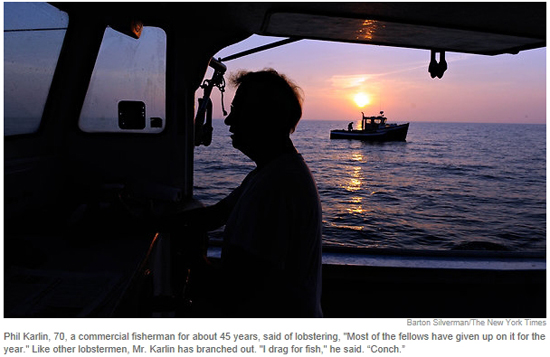Riverhead, NY, August 12, 2011 - As seen in a New York Times feature article last Sunday, it has been 12 years since a great die-off of lobsters in Long Island Sound rocked the local industry and stumped researchers. It lasted three days but wiped out an estimated nine-tenths of the catch, compared with two years earlier.
The past dozen years have not been kind. Adding to potential influences such as global warming, pesticides, lower dissolved oxygen levels, is a bacterial invasion that causes deformities in lobster shells and “reduces the marketability of the product,” said Antoinette Clemetson, New York Sea Grant's marine fisheries specialist. “We’re in the worst possible environmental combination of factors. They’re simultaneous.”
Healthy American lobsters carry complex bacterial communities on their shell; however, lobsters suffering with the disease possess a significantly higher abundance of bacteria. According to research presented at a Fall 2010 Sea Grant Symposium on understanding lobster shell disease, Aquimarina homaria has been consistently isolated from lesions in unusually high abundance when compared to bacterial communities that exist on healthy animals in the wild. This bacterium is believed to be responsible for degrading the shell and scientists managed to simulate the same lesions in a laboratory study using white (Albino) lobsters.
Research presented at the symposium (more of which can be found by clicking here) represents the most recent round of findings related to lobster diseases and die-offs in Southern New England. Prior to scientific studies under this $2.3 million federal grant, the Long Island Sound Lobster Initiative was formed as a result of a July 2000 Congressional allocation of $6.6 million in federal funds to the National Oceanic and Atmospheric Administration to investigate the scientific and economic impacts of 1999's lobster die off. At the time, Congress directed that approximately $3.5 million of those federal funds be dedicated for research investigating potential causes (see New York Times' related feature from October 2004, "Warm Water Cited in Lobster Die-Off" [pdf]). The New York and Connecticut Sea Grant programs each received $165,000 each in federal funding to facilitate communication of the research findings to lobster fishers, resource managers, and the public. A series of newsletters, research summaries, symposia materials and fact sheets resulted throughout the last decade, all of which are archived here.

But, as pointed out in the August 2011 New York Times article, for the last of the lobstermen, the difference lies not in laboratory study findings, but instead — or more likely, does not lie — in the pot at the end of the rope they drag up from the water. First, the good old days: “A pound to two pounds a pot,” said Phil Karlin, a commercial fisherman for about 45 years. “Or two-pounds-plus even. Keepers. We would haul, on the average, 300 or 400 pots a day.” Today’s take is a fraction of that. “Less than a half a pound a pot,” Karlin said. “During the spring this year, it wasn’t even that. Most of the fellows have given up on it for the year. Two-and-a-half pounds of lobsters in five pots — that would be real good right now.”
For more on what Long Island's lobstermen are (and are not) catching today, check out the feature article ("The Last of the Lobstermen" [pdf]) and related blog ("On Long Island, Disappearing Lobsters" [pdf]) from the Sunday New York Times (both of which include a series of pictures) as well as the video clip, "Long Island's Lost Lobsters," which is below.
New York Sea Grant, now in its 40th year, is a statewide network of integrated research, education, and extension services promoting the coastal economic vitality, environmental sustainability and citizen awareness about the State's marine and Great Lakes resources. One of 32 university-based programs under the NOAA’s National Sea Grant College Program, NYSG is a cooperative program of the State University of New York and Cornell University.